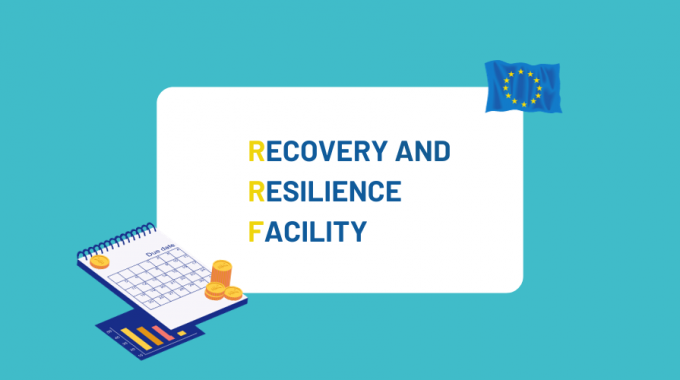Recovery and Resilience Facility (RRF)
What is in there for our sector?

The plan for European recovery, NextGenerationEU (NGEU), is a temporary instrument of €750 billion with the aim of addressing the consequences of COVID-19, and setting the Union on the path to a sustainable and resilient recovery. It takes the form of grants and loans to Member States through the Recovery and Resilience Facility and six other EU spending programmes for the 2021-2027 period.
The funding of the NextGenerationEU amounts to €806.9 billion in current prices, including the Recovery and Resilience Facility of €723.8 billion (338.0 in grants, not included in the calculation of their national debt, and 385.8 in loans) – Pillar 1. The rest (€83.1 billion), is a contribution to other EU programmes (REACT-EU, Just Transition Fund, Rural Development, INVESTEU, Horizon Europe and RESCEU) – Pillar 2.
At least 30% must be allocated to tackling climate change, which could benefit building renovations, production of renewable energy, and increased circularity. New opportunities have also appeared under Pillar 1 with the possibility to add REPowerEU chapter in RRPs.
To benefit from support under the Facility, EU governments have submitted national recovery and resilience plans, outlining the reforms and investments they will implement by end-2026, with clear milestones and targets. The plans had to allocate at least 37% of their budget to green measures and 20% to digital measures.
The Recovery and Resilience Facility is performance based. This means that the Commission only pays out the amounts to each country when they have achieved the agreed milestones and targets towards achieving the reforms and investments included in their plan.
Central governments are the direct beneficiaries of the RRF, thus all financing from the EU will arrive at the national level. Thus, the method by which funds will be distributed at the regional or local level is up to national governments to decide.
Objectives and eligible projects
Objectives and project eligibility criteria for the RRF are indicated in each National Recovery and Resilience Plan, but, in general terms, are similar to the general EU policy’s objectives. All types of projects that minimize the carbon footprint, such as renewable energy buildings and energy production facilities, are eligible.
Type of financing available and ways to access it
Grants and different types of financing are defined by each Member State. To benefit from the RRF, Member States prepared their national Recovery and Resilience Plans, where each country defines the way to access the funds.
Relevance for the social housing sector
While the primary focus of the RRF is on broader economic recovery and resilience, Member States have the flexibility to include housing-related measures within their RRPs. This means that social housing projects, housing energy efficiency improvements, and other housing-related initiatives can be funded through the RRF if they are part of the national recovery and resilience plans.
Example of relevant measure with fulfilled milestones and targets under the social and territorial cohesion pillar ('social protection’ and ‘social housing’ policy areas)
The measures supporting social protection and social housing account for around €28.8 billion. In particular, the measures focus on the effectiveness, quality and resilience of social protection systems. The majority of social protection investments under the RRF relate to upgrading, expanding, or improving the social services network and facilities provided by public and private social institutions. A number of Member States also include important investments to increase the supply of social housing and social infrastructure to disadvantaged groups, using mostly loans.
- Investments in France that supported energy efficiency renovation in social housing by allocating grants to more than 20 000 social dwellings.
REPowerEU
On May 18, 2022, the European Commission introduced the REPowerEU package, which amounts to €300 billion. This package represents an important modification to the Recovery and Resilience Facility (RRF) regulation. As a result of this adjustment, Member States now have the opportunity to integrate a dedicated REPowerEU chapter into their national recovery and resilience plans (RRPs) under the NextGenerationEU framework. This strategic addition enables them to secure funding for pivotal investments and reforms that are in alignment with the objectives outlined in the REPowerEU Action Plan.
The overarching aims of this plan, as outlined in the RepowerEU Action Plan, encompass a comprehensive set of measures aimed at fostering EU energy independence, reducing carbon dioxide (CO2) emissions, and mitigating energy costs for citizens and businesses. Member States are also granted access to technical assistance from the European Commission, facilitated through the Technical Support Instrument (TSI). It is noteworthy that 17 Member States have already received or are presently benefiting from support that is pertinent to the REPowerEU initiative. Furthermore, some of these measures will incorporate a digital dimension, such as the digitalization of energy infrastructure.
Importantly, unlike the initial RRPs, which were solely funded through borrowing under the NextGenerationEU framework, REPowerEU chapters can now draw from a diverse array of funding sources. Following the implementation of the amended RRF Regulation (EU) 2021/241, any adjusted RRP that incorporates a REPowerEU chapter, has the option to request supplementary financial support. This support can be secured in the form of resources originating from the Emissions Trading System (‘ETS’), transfers from the Brexit Adjustment Reserve (‘BAR’), structural funds, and/or loans, providing greater flexibility in financing critical initiatives.
Example of eligible investments
Investment in energy renovations of public buildings and a scaled-up measure on energy renovation of private housing. The primary objective is to provide financial assistance for the energy renovations of public and private buildings, resulting in a reduction in energy consumption within the building sector in the short run, as well as a decrease in the reliance on fossil fuels.